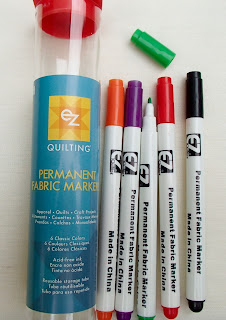Sheree McKee
sewfabsew.blogspot.com
 |
Keep your specialty markers away from family markers
| or you might be disappointed when you really need them! |
Eventually, you will need to address the back of your fiber postcards for correspondence and mailing. It's best to experiment with different marking methods as each type gives different results.
There are many marking options available, including permanent ink pens, gel pens, fabric markers, rubber stamp inks, inkjet transfer printing, inkjet direct printing and more. There are also white inks suitable for dark fabrics, and metallic inks for special touches.
Since fabric postcards are never washed, you don't really have to worry about looking for permanent inks. However, permanent ink might not fade as fast as traditional markers.
 |
| Nancie V. used three colors of marker pens on fine cotton |
 |
| Metallic options |
 |
| Both my never-used whites failed to write and appeared dried up! Perhaps this color sits on the store shelf too long with little demand |
Most fabric postcards are also made with textile backs. Some are created with card stock or different writeable surfaces. These varying backs can affect the quality of handwritten or printed text.
 |
| Cardstock with pigment ink and rubberstamp Yes, you can stitch through card stock I'll blog about that in the future! |
 |
| Judy H. from Canada used muslin backing and Zig Memory System marker |
 |
| Lynn J. used pen on card stock and a cute red rubberstamp |
Sometimes I run into trouble when using fabric markers for writing my postcards out. This usually occurs when I attempt handwriting on rough fabric surfaces, but not on card stock or Tyvek postcard backs.
We've all spent time creating thoughtful fabric postcards to share with others, and it hurts when we spoil the backing. Here's some insight I've discovered ~
CHALLENGES:
We've all spent time creating thoughtful fabric postcards to share with others, and it hurts when we spoil the backing. Here's some insight I've discovered ~
CHALLENGES:
- Markers that blur, wick or run
- Pens that skip in the middle of writing text
- Dull ink without solid saturation or color
- Uneven surface due to texture in the postcard front face
 |
| INKJOY test on fabric, I had to trace over twice on the orange and green. Not very saturated gel colors on fabric. |
 |
| My Fav Sharpie Pen ! |
SOLUTIONS:
TEST AHEAD OF TIME:
HELPFUL WEB ARTICLES:
Compare Stamping Inks on Fabric by Craft Test Dummies
Writing on Fabric by Cheryl Lynch
Marking on Quilts by Sandra Hatch
How to Heat-Set Sakura Pigma at LoveBugStudios
ADDITIONAL RESOURCES:
Yasutomo FabricMate Superfine at Dharma Trading
Zig Fabricolor by Kuretake
Pilot - gel - roller ball - marker pens
Sakura Identi and Pigma pens
EZ Quilting
Marvy Artist by Uchida
Sharpie
InkJoy by Papermate Facebook
- Try handwriting on plain cotton fabric BEFORE it is fused to the back of postcard, because synthetic fusibles often wick through fabrics during ironing, causing resistance.
- Use high thread-count backing fabrics or microfibers for a smoother and a finer writing surface (See Denier details here)
- Be aware that some synthetic fibers often repel inks, use natural fibers such as cotton, rayon, silk
- Trace over text a second time (somewhat challenging)
- Write slowly and evenly
- Store your specialty pens away from family with tightly closed caps
 |
| EZ QUILTING - Nice quality but chunky and thick results |
 |
| MARVY ARTIST - Two tip sizes on each end are very helpful |
 |
| SHARPIE - Fine Points come in many modern colors |
- Make samples of different inks on different surfaces to keep and review.
- Be sure to label them for recalling which markers and methods are working.
 |
| SAKURA Pigma makes a variety of tips sizes and basic colors |
 |
| PILOT roller balls come in several tip sizes |
 |
| SAKURA permanent Identi-pens |
I will cover inkjet printing and transfer in a future blog post, stay tuned. You might like the link below to a previous blog article
on using markers for art:
Thanks! ShereeSews in M!ch!gan
~~~~~~~~~~~~~~~~~~~~~~~~~~~~~~~~~~~~~~~~~~~~~~~~~
Compare Stamping Inks on Fabric by Craft Test Dummies
Writing on Fabric by Cheryl Lynch
Marking on Quilts by Sandra Hatch
How to Heat-Set Sakura Pigma at LoveBugStudios
ADDITIONAL RESOURCES:
Yasutomo FabricMate Superfine at Dharma Trading
Zig Fabricolor by Kuretake
Pilot - gel - roller ball - marker pens
Sakura Identi and Pigma pens
EZ Quilting
Marvy Artist by Uchida
Sharpie
InkJoy by Papermate Facebook



Thanks for the information. I really like the way you express complex topics in lucid way. It really helps me understand it much better way. fine fiber chinese pen
ReplyDelete